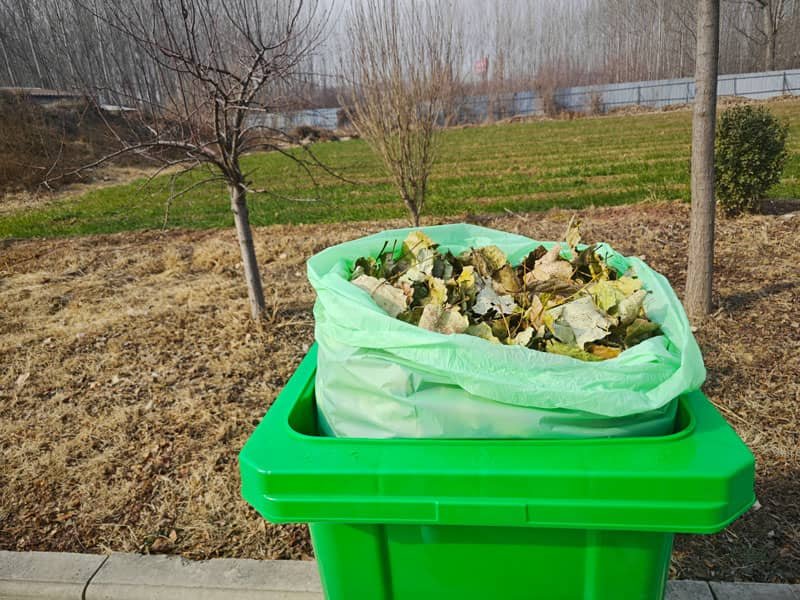The natural landscape of autumn is beautiful, but at the same time, fallen leaves cover our lawns, gardens, and sidewalks, which is a hassle to clean up. In recent years, with the increase in environmental awareness, biodegradable leaf bags have become a new environmentally friendly bag alternative.
In this article, you will learn about biodegradable leaf bags and the difference between them and compostable yard waste bags, including their advantages, their uses, and why switching to biodegradable leaf bags is a smart move for your yard and the earth.

What Are Biodegradable Leaf Bags?
Biodegradable leaf bags are eco-friendly bags used to collect and dispose of yard waste, especially leaves. Unlike traditional plastic bags, they can be naturally decomposed in nature and are made from plant-based materials (corn starch, PLA (polylactic acid), PBAT (polybutylene adipate terephthalate), and even biodegradable paper.
In cities that have completely banned the use of plastic, biodegradable paper bags for yard waste are popular. These paper bags are not only recyclable, but also biodegradable, making them a responsible choice for homeowners and gardeners.
Benefits of Biodegradable Leaf Bags
Environmentally friendly: decomposes naturally without leaving toxic residues or microplastics, reducing your environmental footprint.
Compliant with municipal regulations: Many municipal composting programs now require the use of compostable lawn bags or biodegradable paper bags to dispose of yard waste to ensure it is compatible with green waste disposal systems.
Convenient and durable: biodegradable lawn bags are designed to be durable, waterproof, and suitable for handling heavy yard waste.
Suitable for home composting: Certified bags are suitable for home composting, and you can compost the fallen leaves and bags together.

Biodegradable vs. Compostable Yard Waste Bags
Although the terms are often used interchangeably, biodegradable leaf bags and compostable yard waste bags are not exactly the same:
| Feature | Biodegradable Leaf Bags | Compostable Yard Waste Bags |
|---|---|---|
| Breakdown Time | Varies (weeks to months) | Typically 90 days or less |
| Compost Certification | Not always certified | Often ASTM D6400 or EN13432 |
| Suitable for Green Bin | Sometimes | Yes, if certified |
| Material | Plant starch, PBAT, paper | Plant starch, PLA, certified bioplastics |
When in doubt, look for certifications such as ASTM D6400 or BPI certified compostable, especially for use in regulated city waste programs.
Common Use Cases for Biodegradable Leaf Bags
- Fall Leaf Cleanup: The most common use, especially for homeowners.
- Lawn Maintenance: Collecting grass clippings, small twigs, and brush.
- Garden Cleanup: Great for removing plant trimmings and weeds.
- Community Cleanups: Environmentally responsible option for schools, parks, and city events.
- Landscaping Businesses: Using biodegradable lawn bags can help businesses present an eco-friendly image to clients.
How to Choose the Right Biodegradable Leaf Bag
With so many products on the market, here’s what to consider:
- Capacity: Choose the right size for your needs. For example, 33 gallon compostable trash bags are ideal for large yards or heavy debris.
- Material: Decide between biodegradable paper or bioplastic bags. Paper is better for dry leaves, while bioplastics work well for wetter or heavier materials.
- Certification: Always look for labels like "Compostable," "BPI Certified," or "ASTM D6400 Compliant."
- Durability: Ensure the bag can hold up to the task — whether it’s wet leaves or thorny branches.
- Storage and Shelf Life: Keep bags in a cool, dry place. Most biodegradable leaf bags have a shelf life of 12–18 months.
Why Eco-Friendly Leaf Bags Are Important
The shift to biodegradable leaf bags is inevitable. Traditional plastic bags contribute to long-term environmental degradation. By choosing biodegradable or compostable yard waste bags, you're actively reducing your carbon footprint, supporting sustainable waste management, and promoting green living.
Whether you're a homeowner cleaning up after a storm or a landscaping company looking for eco-friendly alternatives, using recyclable leaf bags, biodegradable paper yard waste bags, or 33-gallon compostable trash bags sends a message: you care about the planet.

FAQs
Are biodegradable leaf bags allowed in green bins?
It depends on your local municipal composting guidelines. Most cities accept compostable lawn bags with certifications, but generic biodegradable leaf bags may not qualify.
What’s the difference between recyclable and biodegradable leaf bags?
Recyclable leaf bags (often paper) can be processed through recycling systems, whereas biodegradable bags break down in compost or soil naturally.
Do biodegradable bags break down too quickly?
No, high-quality biodegradable lawn bags are designed to remain intact during use and begin degrading only in composting conditions.
Can I store them in my garage year-round?
Yes, but store them in a dry, cool place away from direct sunlight to extend shelf life.





